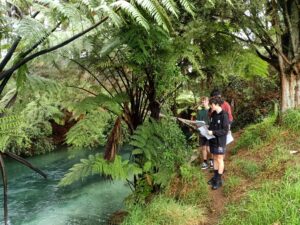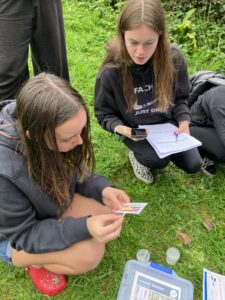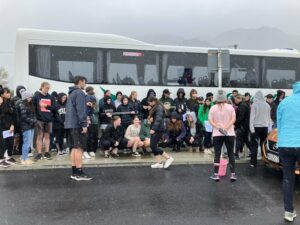Waikato Enviroschools is working to increase reach and engagement by offering a “Friends of Enviroschools” option – a way of working with schools through one-off projects that provide a taste of what we can offer and a start to building a relationship with the potential to on-board the school when they are ready. Until recently, we waited until additional funding was secured before we were able to support new schools with the programme. The “Friends of Enviroschools” option has allowed us to provide a measure of support to interested schools while additional funding is sought.

Checking out the vegetation on the side of the stream along the Te Waihou Walkway next to the spring.
At the beginning of 2023, Morrinsville College requested practical hands-on support for NCEA assessments in their local environment. The geography classes (80 level 2 & 3 students) were looking to assess human impacts on a local natural feature – the Waihou River. The geography teachers and Enviroschools facilitator, Alex, worked together to design a field trip that would allow students to collect data at two sites along the river – at the natural source, natural springs near Putāruru , and approximately 20kms downstream at Te Aroha.
Te Waihou/The Blue Spring near Putāruru , is the source of the Waihou River. At the spring, over 40 cubic metres of crystal-clear water a minute pumps into the Waihou River after spending hundreds of years moving into aquifers high in the Mamaku ranges. Students got to view the pristine water close up and measured velocity, temperature, clarity, habitat and macroinvertebrate communities to assess the health of the waterway. They were blown away by how clear the water was and the plethora of tiny creatures (macroinvertebrates) thriving in the stream.
The class then followed the river by bus to Te Aroha, taking note of land use (proximity of stock to the waterway and areas with and without riparian planting), and completed the same assessments, noting considerable change in a relatively short distance. The rainfall had been high and there was some flooding, a visible reminder of changes in our weather patterns and a question starter on human-induced climate change. While students had the opportunity to discuss visible impacts from the way we use our land, they also explored ideas for what could be done to reduce or mitigate these impacts.

Being freshwater detectives.
Students were able see and experience change, in a real-world context, and use the information to complete their NCEA assessments. Not all students thrive within classroom settings and classroom-based learning, so being able to offer hands-on learning in a meaningful way was incredibly powerful. Enviroschools was able to provide technical knowledge, equipment and support to enable this learning outside the classroom to happen, and supported teachers to deliver a rich learning experience that met their NCEA assessment needs.
Contacts were shared, and the offer was made for further support and engagement should the school be interested. Staff were emailed information about some upcoming secondary opportunities and the offer was left open. A term later, another staff member reached out, interested in signing up the school to become an Enviroschool!
While still at the beginning of the journey it is always exciting to bring a new school on board and work with staff to see how we can best support them, especially in the secondary sector. Increasingly we are able to support NCEA curriculum in Science, Social Science and the relatively new Education for Sustainability subjects.

Facilitator, Alex, talks to students about habitat assessment.

College students fill out the macro-invertebrate score sheets at Te Aroha.

Students collect, identify and count macro-invertebrate to gauge stream health.

No shortage of water – showing resilience as budding freshwater scientists.
![]()
Reference: https://readwrite.com/gambling/betting/california/
